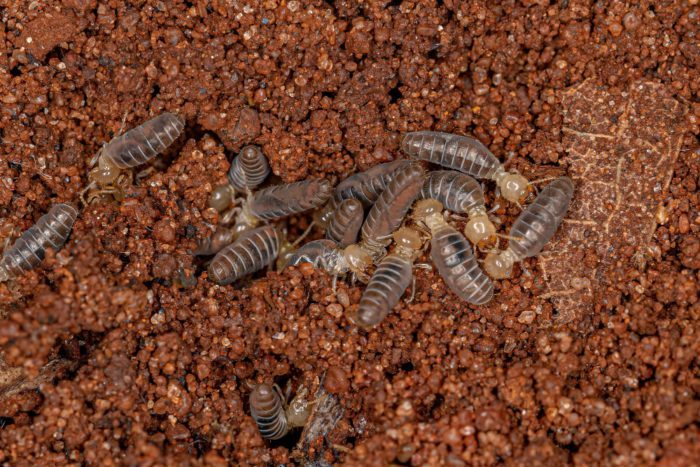Termites are a common problem for homeowners. We have a general idea about the damage they cause.
Mud tubes, hollow sounds from the wood are signs of their presence. But due to their small size, we don’t have an idea about their appearance.
What do they look like? Are all kinds of termites the same in appearance?
All these questions will be answered through this article.
Before jumping to the appearance we will try to understand why it is difficult to identify termites.
Why is it Difficult to Identify Termites?

The reason why we are having this section is that many bugs look similar to termites. The damage pattern is also similar.
Here are some bugs that look like termites.
Carpenter Ants
The main reasons why people confuse these with termites are because they both damage wood, and they both fly in large numbers. Carpenter ants too create holes in wood and leave the excess behind.
Flying Ants
Carpenter ants aren’t the only species of ants that fly. The main similarity between the flying ants and termites is their purpose. They both fly in search of a new place so that they can mate and start a new colony.
Carpenter Bee
These tunnel into the wood through holes that resemble termites’ kick-out holes (tiny holes created during drilling and used for ejection). The presence of these holes can make you think that there are termites in your house.
The difference is the extent of the damage. Since these bees live alone, the damage is much less as compared to termites.
What Do Termites Look Like?

To have a better understanding of their appearance we have divided their appearance into three categories i.e length, body type, and color.
Let’s begin.
Length
The usual length lies between ¼ to ½ inches.
Subterranean termites are smaller species and grow up to ¼ of an inch only. Although they are smaller in length, the size of their colony is much larger than the other termites. These are prevalent across the United States.
Drywood termites length lies between ⅜ and ½ inches. Since they usually live in warm and tropical climates, they can be found in California, Florida, and Hawaii.
Formosan termite is another common type of termite mainly found in the southeast U.S and Hawaii. They are usually ½ to ⅖ inches in length. They can easily surpass the colony size of any other termite species specifically in North America as there are millions of termites present in a single colony.
Body
The bodies of termites are soft and thick. Their head region is very distinct and hard. Its appendages are very powerful. The head is fixed with straight antennae having beads attached to them.
When it comes to flying termites, there are two pairs of wings, one at the front end and the other at the rear end. Both the pairs are equal in length and longer than the body. Since they are fragile, they can easily fall off.
Color
The color of termites depends on the kind of species they are and the caste they belong to.
We know about the types of termites but some of us are not familiar with the caste, so to make things easy, we will have a short discussion on the caste of termites.
There are three castes within their colony. Each has its purpose.
The first one is the workers. They make up the majority of the termites in a colony. Their work is to build nests, create tunnels, and look for food sources.
Second, comes the soldier termites. Their job is to defend the colonies from any kind of attack. They are typically smaller than the other castes.
Last comes the alates. These are the reproductive termites, who leave their colony in search of a mate and a location. After finding these, they mate and develop a colony.
Now let’s come to the color part.
When it comes to subterranean termites, their workers and soldiers are pale or cream-colored. The head of a worker termite can be orange. The reproductive subterranean termites have a dark-colored body.
The workers and soldiers of drywood termites have whitish bodies with the soldiers having brown heads. The bodies of reproductive termites are dark brown with their head amber-colored. Their wings are gray.
Formosan soldier termites are similar to subterranean ones having white bodies with their heads orange in color. The workers are also whitish similar to subterranean and drywood worker termites.
The reproductive Formosan termites are a bit different from the workers and soldiers. Their body color is not similar to any other type of termite. It ranges from pale to yellow-tinted brown.
Identifying Subterranean and Drywood Termites

Both of these are common types of termites that are found in households. Since their size is very small, it is very tough to distinguish between them.
But it is important to identify them in order to pick the appropriate treatment. To make the identification easy, we are going to discuss the damaging pattern of subterranean and drywood termites.
Subterranean Termites
Their feeding begins with timber from the ground. They access the building through its substructure.
Their damage includes the presence of mud tubes and hollow tunnels in the wooden structures. The hollow tunnels run through the grain of the wood as it is softer and easier to eat.
Drywood Termites
They access the building through its rooftop or any wood that is exposed outside. They usually create tiny holes in the wooden structure. These holes are created during the drilling process and later on used for the ejection of their feces.
So to locate the damage of drywood termite, we have to look for tiny holes and their feces that are dropped from these holes. The feces look like sawdust composed of even-sized grains with six sides.
Conclusion
Identification of termites and their damage is very necessary as many other species cause the same type of damage and their appearance is also quite similar.
In case of confusion, we may select the wrong treatment. So to avoid this, always examine the damage and then go for pest treatment. It is advised to call the professionals for the examination process.
